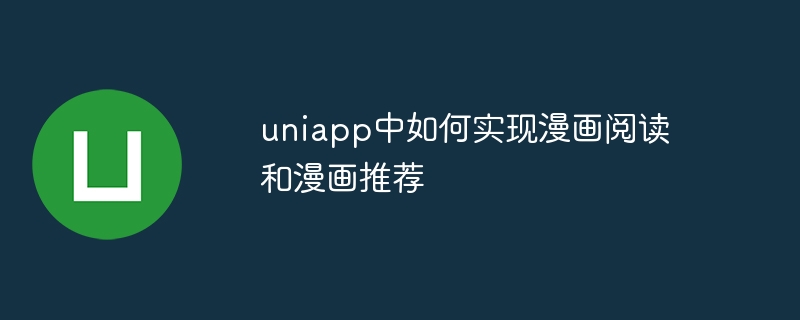How to implement comic reading and comic recommendation in uniapp

UniApp is a cross-platform application development framework based on Vue.js, which can compile code into multiple platforms such as mini programs, H5, and Apps. Implementing comic reading and comic recommendation in UniApp requires data acquisition, page display, user interaction and other aspects. The following is a simple example to demonstrate how to implement comic reading and comic recommendation functions in UniApp.
- Data acquisition
To achieve comic reading and comic recommendation, you first need to obtain comic-related data from the background. You can use the uni.request method to send requests and get data. For example, you can send a request in the onLoad method to obtain the comic list data and store it in data:
onLoad() {
uni.request({
url: 'https://example.com/api/comics',
success: res => {
this.setData({
comics: res.data
})
},
fail: err => {
console.log(err)
}
})
},- Comic Reading
To implement the comic reading function, you can use the swiper component to display comics page, and update the current page number in the swiper's change event. For example, you can use the swiper component in the page to display comics pictures:
<swiper class="comic-swiper" :current="currentIndex" @change="swiperChange">
<swiper-item v-for="(item, index) in comics[currentComicIndex].pages" :key="index">
<img class="comic-image lazy" src="/static/imghw/default1.png" data-src="item" : alt="How to implement comic reading and comic recommendation in uniapp" >
</swiper-item>
</swiper>You can define the swiperChange method in methods to update the current page number:
swiperChange(e) {
this.currentIndex = e.detail.current
},- Comic recommendations
To implement the comic recommendation function, relevant comics can be recommended based on the user's reading preferences and comic tags and other information. For example, you can use the uni.request method on the page to obtain the data of recommended comics and display the data on the page:
onLoad() {
// 获取漫画列表数据
// 获取推荐漫画数据
uni.request({
url: 'https://example.com/api/recommend',
success: res => {
this.setData({
recommendComics: res.data
})
},
fail: err => {
console.log(err)
}
})
},Then display the data of recommended comics on the page:
<view v-for="item in recommendComics" :key="item.id" class="recommend-item">
<image :src="item.coverUrl" class="recommend-cover"></image>
<text class="recommend-title">{{item.title}}</text>
</view>The above is an example of comic reading and comic recommendation in a simple UniApp. In actual applications, functions such as interface design, user interaction, and data processing can be further improved according to needs.
The above is the detailed content of How to implement comic reading and comic recommendation in uniapp. For more information, please follow other related articles on the PHP Chinese website!

Hot AI Tools

Undresser.AI Undress
AI-powered app for creating realistic nude photos

AI Clothes Remover
Online AI tool for removing clothes from photos.

Undress AI Tool
Undress images for free

Clothoff.io
AI clothes remover

Video Face Swap
Swap faces in any video effortlessly with our completely free AI face swap tool!

Hot Article

Hot Tools

Notepad++7.3.1
Easy-to-use and free code editor

SublimeText3 Chinese version
Chinese version, very easy to use

Zend Studio 13.0.1
Powerful PHP integrated development environment

Dreamweaver CS6
Visual web development tools

SublimeText3 Mac version
God-level code editing software (SublimeText3)

Hot Topics
 1387
1387
 52
52
 What are the different types of testing that you can perform in a UniApp application?
Mar 27, 2025 pm 04:59 PM
What are the different types of testing that you can perform in a UniApp application?
Mar 27, 2025 pm 04:59 PM
The article discusses various testing types for UniApp applications, including unit, integration, functional, UI/UX, performance, cross-platform, and security testing. It also covers ensuring cross-platform compatibility and recommends tools like Jes
 How can you reduce the size of your UniApp application package?
Mar 27, 2025 pm 04:45 PM
How can you reduce the size of your UniApp application package?
Mar 27, 2025 pm 04:45 PM
The article discusses strategies to reduce UniApp package size, focusing on code optimization, resource management, and techniques like code splitting and lazy loading.
 What debugging tools are available for UniApp development?
Mar 27, 2025 pm 05:05 PM
What debugging tools are available for UniApp development?
Mar 27, 2025 pm 05:05 PM
The article discusses debugging tools and best practices for UniApp development, focusing on tools like HBuilderX, WeChat Developer Tools, and Chrome DevTools.
 How can you use lazy loading to improve performance?
Mar 27, 2025 pm 04:47 PM
How can you use lazy loading to improve performance?
Mar 27, 2025 pm 04:47 PM
Lazy loading defers non-critical resources to improve site performance, reducing load times and data usage. Key practices include prioritizing critical content and using efficient APIs.
 How can you optimize images for web performance in UniApp?
Mar 27, 2025 pm 04:50 PM
How can you optimize images for web performance in UniApp?
Mar 27, 2025 pm 04:50 PM
The article discusses optimizing images in UniApp for better web performance through compression, responsive design, lazy loading, caching, and using WebP format.
 What are some common patterns for managing complex data structures in UniApp?
Mar 25, 2025 pm 02:31 PM
What are some common patterns for managing complex data structures in UniApp?
Mar 25, 2025 pm 02:31 PM
The article discusses managing complex data structures in UniApp, focusing on patterns like Singleton, Observer, Factory, and State, and strategies for handling data state changes using Vuex and Vue 3 Composition API.
 What are computed properties in UniApp? How are they used?
Mar 25, 2025 pm 02:23 PM
What are computed properties in UniApp? How are they used?
Mar 25, 2025 pm 02:23 PM
UniApp's computed properties, derived from Vue.js, enhance development by providing reactive, reusable, and optimized data handling. They automatically update when dependencies change, offering performance benefits and simplifying state management co
 How does UniApp handle global configuration and styling?
Mar 25, 2025 pm 02:20 PM
How does UniApp handle global configuration and styling?
Mar 25, 2025 pm 02:20 PM
UniApp manages global configuration via manifest.json and styling through app.vue or app.scss, using uni.scss for variables and mixins. Best practices include using SCSS, modular styles, and responsive design.




